
System Context
The Harmony DAC will be listened to in the main system in combination with the Antipodes Oladra Music Server, the Aqua LinQ Network Interface, and the Aqua La Diva M2 CD transport. The rest of the system comprises the CH Precision L1 preamplifier, CH Precision A1.5 power amp, and Magico S1 MkII speakers.
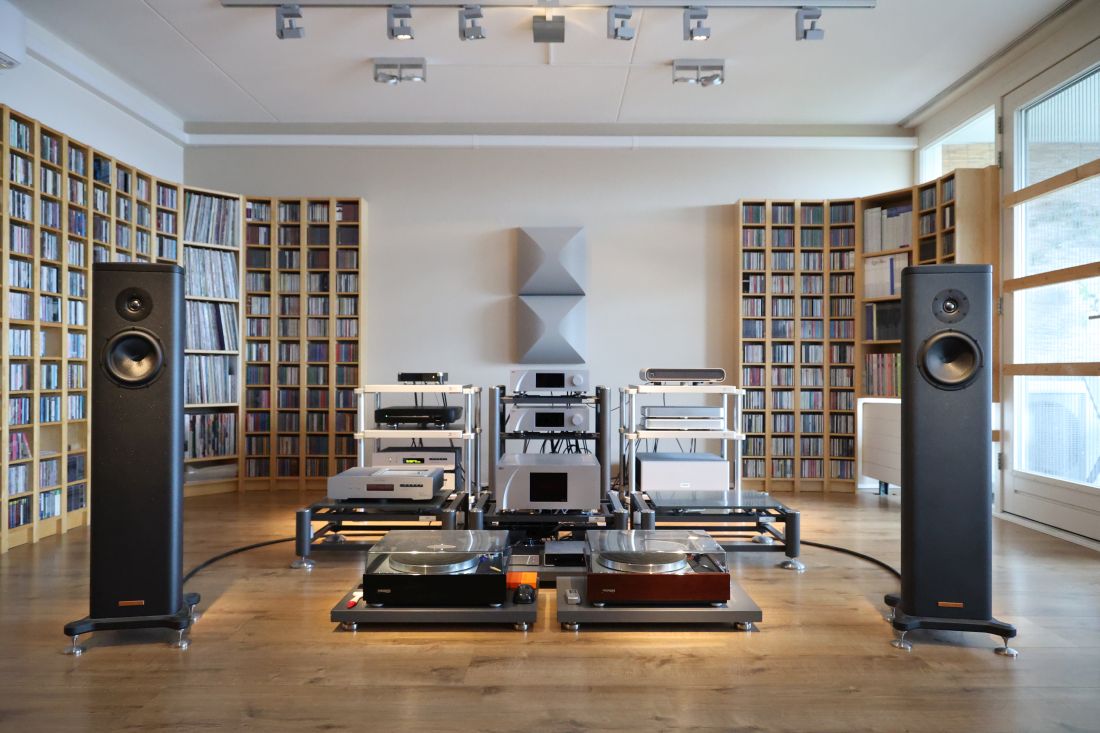
Listening
When it comes to DACs, I find there are two prevalent yet distinctly different sonic directions. On the one hand, we have a smooth, rich, and lush presentation; on the other, we have a crisp, clean, and precise presentation. The Harmony DAC positions itself solidly in the latter category. It has a hugely revealing nature, but it is also very natural, and thanks to a remarkably punchy and solid foundation and a complete absence of artifice, it is also thoroughly musical and emotionally involving. This is an important aspect to note as I have found many DACs’ otherwise technically excellent performance spoilt by a synthetic and unrealistic timbre. With the Harmony DAC, this is not a concern.
Two other DAC brands spring to mind when listening to the LAiV: Cos and Denafrips. From memory, I feel the Harmony DAC has similar precision, tightness, and control as the Cos D10 MkII, but with more body and a more solid foundation. Likewise, I feel it combines several virtues of Denafrips DACs, such as the air and refinement of the Venus, with the body, propulsion, and conviction of the Pontus. While on the topic of Denafrips, as one might expect, given the significant disparity in price, the famous Terminator DAC sets the bar even higher in terms of fluidity, delicacy, resolution, and transparency. But it must be said: the LAiV combines many virtues of other DACs and combines them seamlessly, with immense clarity and plenty of heft and punch.
Using Driade Flow Link Reference 808 interlinks, the XLR and RCA outputs sound as close to one another as I have heard. As ever, slight differences remain, in line with how they usually pan out, with XLR sounding a little cleaner and more controlled and RCA a little freer and more playful. The sonic differences between different brands of cables and their synergy with the preamp or integrated amp are of much more significant influence.
The Harmony DAC is very easy to use and works without any configuration, but for those who wish to fine-tune it to their personal preferences, there are four aspects to pay attention to.
Tweaks
First, there’s the option to use Oversampling (OS mode) or a more direct output (NOS mode). The manual explains the technical background in detail. With most DACs, I usually prefer NOS as this leads to the most direct and pure path, and the Harmony DAC is no exception. On the other hand, Oversampling leads to a smoother, more liquid sound, which may be preferable in different systems or to other ears. Like all the DAC’s settings, this adjustment can be made from the listening position using the remote control.
The second tuning option is to couple or decouple the chassis from the ground. This feature can optimize the grounding scheme using additional grounding equipment and/or allows tweaking the sound according to personal preference. In short, when the chassis is grounded, the presentation is firmer, tighter, and more forward. Without chassis grounding, the DAC sounds more relaxed.
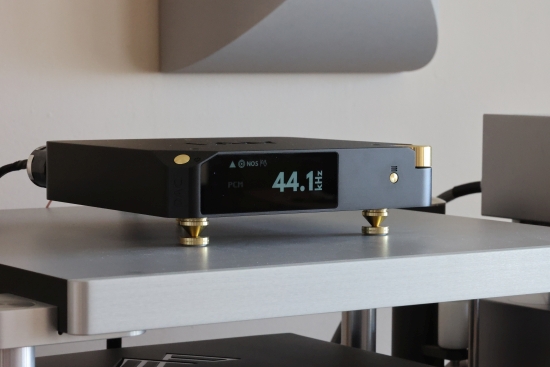
The third aspect concerns the included spikes and discs or aftermarket footers. Using the spikes with the included discs, I found the DAC to sound impressively detailed, crisp, and immediate, but I also felt the sound could sometimes be a little too spicy in the upper mid and lower treble region. Removing the discs and using the spikes directly on the HRS EXR stand’s platform restored the balance.
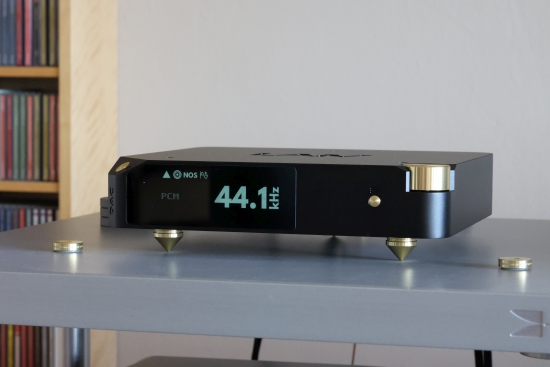
Alternatively, aftermarket footers can be used. I obtained the best results using Ansuz Darkz T2 or T2S Resonance Control Devices. These models are admittedly priced extravagantly in contrast with the Harmony DAC’s price, but they clearly illustrate its resolving power. It’s worth mentioning that even the entry-level C2T Darkz footers elicit an improvement from the DAC.
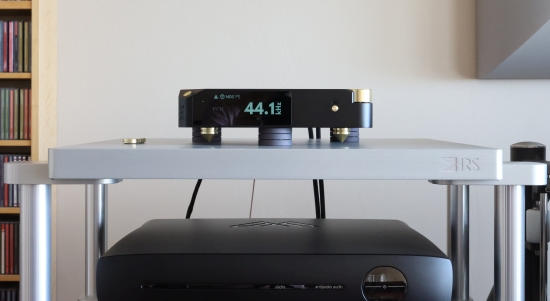
The final aspect is the power cable choice, which should not be underestimated. For servers, I often use one of two homemade cables consisting of litze or solid core copper in PTFE dielectric/tubing to good effect. However, both these cables made the DAC sound overly dry and desaturated. But this is not to say it needs a very lush or full-sounding cable, as I found the ideal balance was obtained using the GigaWatt LC-2 EVO. This cable injected the sound with the perfect dose of saturation, flow, and overall musicality while retaining the resolution and openness. In any case, this DAC’s revealing nature makes it absolutely worthwhile to take the time to find the ideal cable for the given system.
Continued Listening
Even without considering the above hints, the Harmony DAC performs superbly well, easily outperforming nearly all other DACs I heard at its price level. Its ability to do so from such a small and attractive package is also a pleasant surprise. Now that we have established the baseline, let’s investigate its various inputs and outputs.
So far, I’ve used the RCA S/PDIF input using the Aqua LinQ Network Player and La Diva M2 CD transport, which are both very neutral and realistic-sounding players but with a different emphasis. The LinQ is more concrete, direct, and expressive but, under certain circumstances, perhaps a little dry. The La Diva M2 is more liquid and relaxed but relatively mellow unless paired with rigid couplers such as StillPoints. Despite their relative differences, both sources work equally well with the Harmony DAC, and the ideal synergistic match will come down to system synergy and user preference.
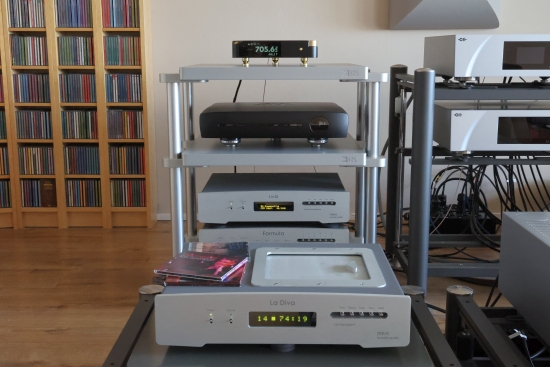
Let’s see how the Harmony DAC performs with another server and how coax compares to USB. For this, I will use the Antipodes Oladra music server. As regular readers may know, this server’s Reclocker outputs (S/PDIF and AES/EBU) always produced the most liquid and organic presentation, while its USB output sounded comparatively mechanical and controlled. However, with the latest G4 revision, this changed. Although USB still sounds different from the server’s other outputs, it has shed most of its mechanical nature while retaining precision, clarity, and transparency. Of all its available server/player software solutions, MinimServer with MinimPlayer produces the best sound to my ears, and that is what I have been using lately, and it is also what I used for this review. Before switching to USB, I connected the server’s coaxial output to set the baseline.
Sure enough, the Oladra’s Reclocker outputs still have a magical touch, providing enhanced fluidity, air, and flow compared to Roon streaming via Squeeze protocol to the Aqua LinQ. In some ways, this is a more stereotypically analog delivery. On the other hand, this presentation is not quite as robust and impactful as when using the Aqua, even though we’re comparing UPnP on the Oladra to Roon/Squeeze with the LinQ.
Between the two sources, it comes down to user preference more than anything. But this illustrates beautifully that even though the Harmony DAC is very revealing and analytical, it does not superimpose a technical or clinical quality in and of itself.
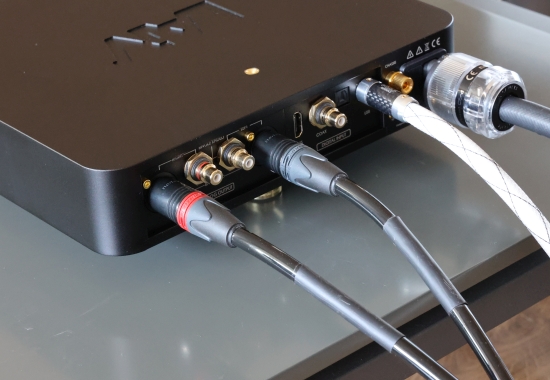
The Oladra/Harmony DAC combo takes a huge leap in solidity and control when switching from coaxial to USB. The Vermouth Reference USB cable is still a favorite for its even-handedness and ability to work well with virtually any source and DAC, but it is not the most robust or expressive cable I have. Nevertheless, with this cable, the DAC provides excellent clarity and transparency, combined with good articulation and toe-tapping PRaT, topped off with beguiling fluidity, refinement, and air. This result speaks clearly to the quality of the USB interfaces on both ends.
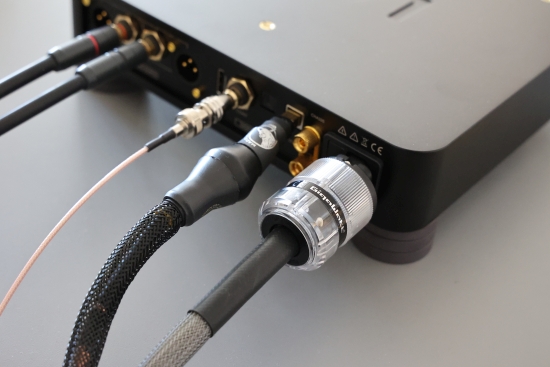
When finally using the Mad Scientist Prime USB, the sound takes a further massive step up by re-adding the robustness, impact, and timbral fulness, which went missing when switching from the LinQ to the Oladra, culminating in a performance that is very precise as well as emotionally satisfying.
Finally, I also tested the DAC’s I2S functionality.
I2S can be a two-edged sword because there is no universally agreed-upon standard for the pin layout. The Oladra addresses this by allowing users to configure the pinout via DIP switches on the bottom. While this works, it’s not very convenient with such a heavy device. The LAiV Harmony DAC goes one step further by implementing auto-configuration for I2S.
I don’t have a high-end HDMI cable, so I always use a good-quality, no-nonsense standard cable. Nevertheless, the format always produces good results. And sure enough, after connecting the HDMI cable and selecting its input, it worked right away. In my experience so far, I2S has very nearly always sounded better than AES/EBU and S/PDIF, and the LAiV DAC is no exception. What I2S brings is the naturalness and unrestrained flow of the Coax connection, combined with a large portion of the articulation, crispness, and tightness of the USB connection. When comparing I2S to USB, I’m tempted to conclude that the cable used will be a more significant factor in determining the sonic character than the chosen interface. On the other hand, USB remains more controlled while traditional inputs remain more free-flowing, meaning that user preferences will also be a significant deciding factor. For me, I2S would be the interface of choice.
When comparing the two front ends using these various connection methods, certain differences remain, but that will always be the case. What matters is that, through all my tests using different sources and connection methods, the Harmony DAC proved to be highly revealing but also highly accommodating. This beautiful DAC can be paired with a wide range of sources.
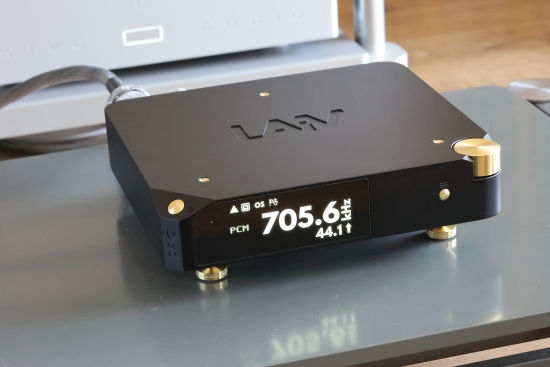
Conclusion
The beautifully sculpted Harmony DAC has a hugely revealing nature, but it is timbrally realistic, natural, and much like a chameleon. Combine it with a super-accurate and neutral source, and the DAC’s analytical quality will relay this in all its precision. Conversely, when combined with an organic and liquid-sounding source, the DAC will also relay the music in all its lushness and sweetness without overlaying any character of its own.
This is what I think a high-performance DAC should be like: not a component to EQ your system with but an open window onto your source. Such excellent performance usually comes with a much heftier price tag, and it is a miracle that the Harmony DAC achieves this at such a reasonable price point.

External Links
Manufacturer: LAiV Audio

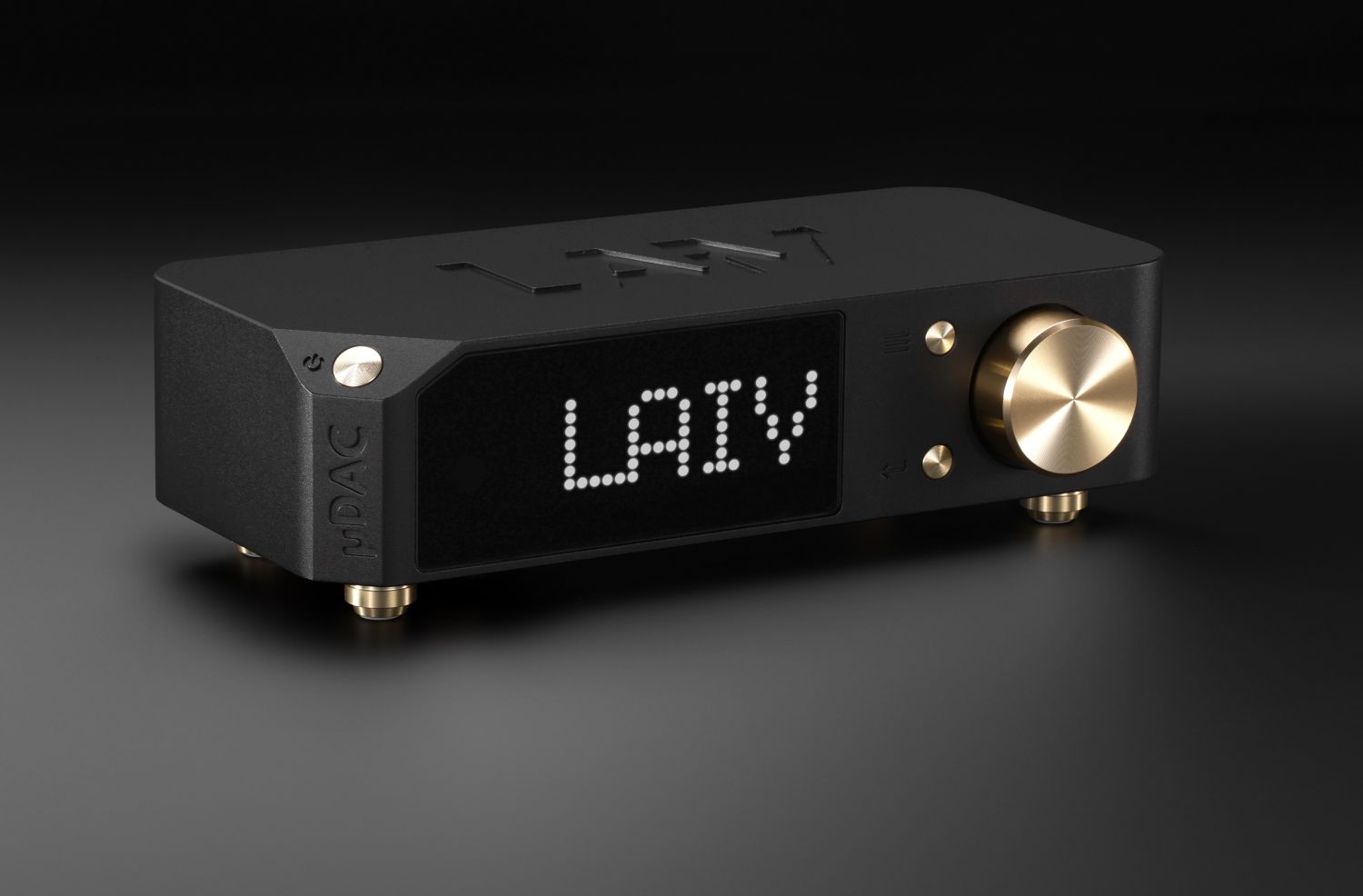





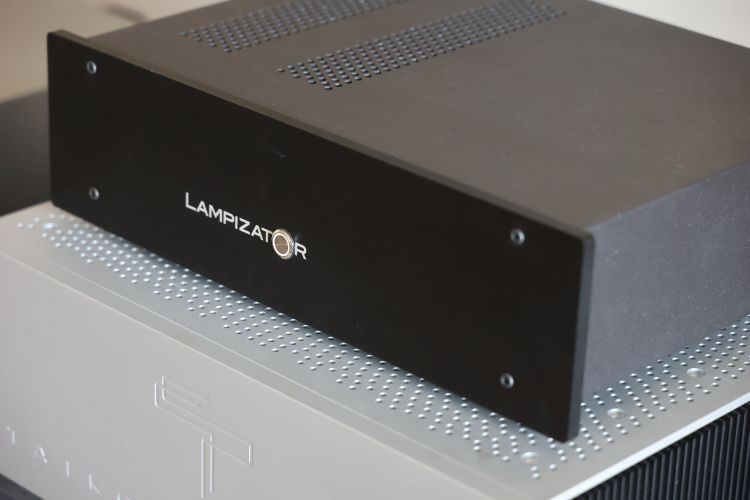
Nice review, thanks! Questions: how would you describe the sound stage (width/depth) of the Harmony? What qualities will improve when switching to a CNO DAC (like TOTL Wadax, Taiko, MSB etc)?
Hi Vincent, the Harmony DAC sounds upfront and well-focused. The stage is not narrow although some DACs in the same price range can sound wider. On the other hand, those DACs are invariably also less resolving. The Aqua Formula xHD has a deeper soundstage but it does not feel as crisp and direct as the Harmony DAC.
I don’t think people entertaining Wadax, MSB, or CH will consider a 2700-euro DAC, but I can see how it may be of interest the other way around. If you’re interested to know how close the Laiv gets to reference performance, I can say closer than one might expect given the large price disparity, but certainly not as close to make me want to switch. All brands and DACs have their inherent qualities, but overall, what you often gain in the ultra high end compared to medium-priced products is increased naturalness, refinement, soundstaging, and air. Interestingly, I find there’s not often a huge increase in resolution.
Your statements regarding USB cables and power cables are laughably ridiculous. How gullible do you think your readers are? How about we do a truly blind test of these cables? I’ll gladly wager real money that the author cannot tell one cable from the next. Real money wager. Please take me up on it.
Hi Christiaan,
what I missed was a comparison vs the Aqua Formula DAC.
So if you did this comparison without mentioning it in the review I am very curious to get some info about this comparison. I ask since you compared another DAC which is on my shortlist vs the Aqua Formula. Thank you.
The Laiv Harmony and Aqua Formula xHD are in such a different price class that I feel it would not make much sense comparing them. I know I have, and often still do involve ultra-high-end equipment in affordable equipment reviews, but it depends on the circumstances, and whether I feel it is needed to bring the message across. At the end of the day, I can do comparisons forever, but I’ve been told my reviews are already quite long;-). In a nutshell: the Formula xHD sounds fuller, sweeter, and more laidback with deeper staging, whereas the Laiv is crisper and more direct and upfront. The resolution between the two is comparable although the Laiv can appear clearer due to its crisp presentation.
Hi Christiaan,
Your observations on improvements depending on inputs used, that is coaxial versus USB are well noted. I would love to see the same with respect to I2S
Kindest Regards
Hi Tim, Good point! I forgot testing that, but will do! Please expect an update of the review within the next hours:-).
Hi Christiaan,
I like very much your reviews since you are a reviewer who does very valid comparisons. Many reviewers don’t dare to compare devices.
However, I would like to suggest that every device under review gets a comparison versus your reference components in your main system even when there is a big price difference. This would be very helpful.
Thank you very much.
Hi Matt, I will surely involve the CH C1.2 when I see a need for it. For instance, when reviewing other reference-class DACs. Another circumstance could be when a cheaper DAC outperforms the more expensive one. In that case, I will definitely mention this. However, in this case, where the balance is as one would expect with such an expensive DAC, with the CH performing on a higher overall level, mentioning this doesn’t add anything in my opinion.
Great review! I love this DAC
A typically excellent and thorough review thanks Christian and a very stylish Dac. I can see it making a lot of listeners happy eyes and ears both.
Cheers,
Jon
Hi…now there is very interesting things with all these R2r dacs and this price niche of a Laiv Harmony – as you allready tested bunch of Denafrips dacs and from price point i think this Laiv is in line with Denafrips Venus how you would compate this two (btw it look that new Pontus 15th is a Venus 12th in a box of Pontus) ….Thank you in advance….
Hi Denis, I have not heard the Pontus 15th and do not know the specifics. The latest model iterations sure are making things confusing. In any case, I have written a few words about Denafrips versus Laiv in the review above.
Hi Christiaan,
Very nice review!
I just switched from Naïm to Audionet Humboldt. Speakers Magico S3mk2.
Streamer NDX2 has to go soon.
Do you think the Harmony DAC is a good match? Thinking of buying a Grimm MU1. Or do you have other sugestions?
Thank you in advance!
Kind Regards
Olivier
Hi Olivier, I think the Harmony DAC will work very well with Magico S3 MkII. The Grimm MU1 is one of the best Roon servers I know at the price point. Whether or not it is ideal for you depends on your personal preferences. Some Roon servers, such as those by Antipodes have a smoother and more voluptuous sound but that does come at the expense of a measure of precision and transparency. You can also move in the opposite direction, with more precise and articulate sound that can be obtained by using UPnP, and the best option at the MU1’s price point would be the XACT S1.
Hi Christiaan, can I ask you for advice?
I still didn’t buy a streamer to replace my Naim NDX2 but now I got an offer for a DCS Rossini (2018) with APEX update (2023) for 17.000.
What is your opinion about the DCS Rossini?
Groet,
Olivier
Hi Olivier, Sorry, I cannot get into topics unrelated to my articles.
Do you have a chance to try the uDDC Laiv with the Harmony Dac? I’m interested in your opinions
Thanks Mario
I am currently finalizing the HP2A + LExt IN2 review. After that, the uDDC might be a possibility, but this has not yet been discussed.
thanks
Sorry to ask about another comparison, but how would you expect that the Tambaqui might compare with the Laiv Harmony? I have a Tambaqui that I do enjoy, but I wouldn’t be opposed to downgrading to put the funds elsewhere. Also in general I do gravitate to the crisper presentation style that you noted in the review.
All I can say is that they steer in a similar overall sonic direction, but I do not know how they compare precisely. It’s impossible to provide a more detailed analysis without ever having had them side by side.
I have an Aqua transport. Can I play cd’s running I2s out into the Harmony I2s input?
Aqua’s AQLink interface might technically be compatible with other I2S devices (if the pinout matches), but the connectors are different. HDMI for LAiV and RJ-45 for Aqua. So, in order to try this, you’d have to make a custom cable.
There is an adapter to convert RJ-45 to HDMI. Good to know that the Aqua might be more compatible with other I2s dacs.
Thanks.